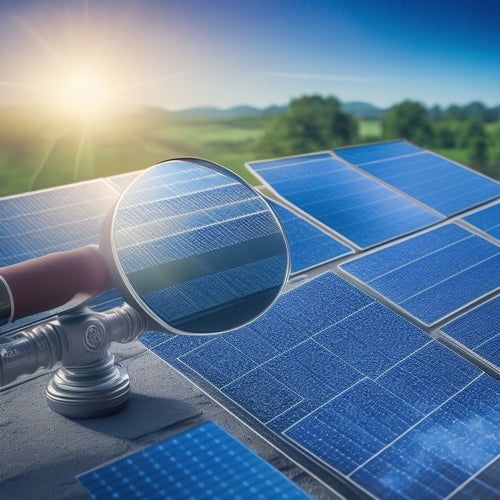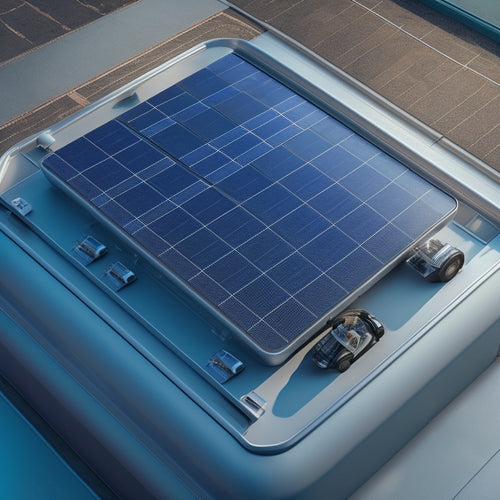
Installing Small Home Renewable Energy Systems: A Guide
Share
You're taking the first step towards reducing your carbon footprint by considering a small home renewable energy system. To get started, evaluate your energy needs by monitoring your usage patterns and identifying areas of inefficiency. Next, select the right solar panels based on efficiency ratings, warranties, and certifications. Assess your roof's suitability, considering factors like size, orientation, and shading. You'll also need to factor in installation and maintenance costs, as well as explore incentives and rebates that can help offset expenses. As you move forward, you'll uncover more key considerations that will help you make the most of your renewable energy investment.
Key Takeaways
• Assess your energy needs by evaluating usage patterns, conducting an energy audit, and monitoring energy usage to determine system size.
• Select high-efficiency solar panels with a rating above 20%, considering warranty, durability, and certifications.
• Ensure your roof is suitable for solar panels by evaluating size, orientation, condition, and shading factors.
• Factor in upfront installation costs, ongoing maintenance expenses, and consider budgeting for a Battery Backup system.
• Take advantage of incentives, including tax credits, government grants, cash rebates, and net metering to maximize savings and affordability.
Understanding Your Energy Needs
Evaluating your energy usage patterns is essential to determining the size and type of renewable energy system that will effectively meet your needs. Think of it like trying on shoes - you need to know your size before you buy.
Conducting an energy audit will help you identify areas of energy inefficiency and pinpoint opportunities for improvement. Don't worry, it's not as intimidating as it sounds! A simple energy audit involves tracking your energy usage over time to identify patterns and trends.
You'll want to monitor your energy usage during different times of the day, week, and year to get an accurate picture of your energy patterns. This will help you understand when and how you use energy, and how much you need to generate to meet your needs.
Choosing the Right Solar Panels
Choosing the Right Solar Panels
With numerous solar panel options available, you must take into account several key factors in order to choose the right ones for your small home renewable energy system. Panel efficiency is an important consideration, as it determines how much energy your system can generate. Look for panels with high efficiency ratings, typically above 20%, to maximize your energy output.
Additionally, consider the warranty options offered by manufacturers. A thorough warranty can provide peace of mind and protect your investment in case of defects or performance issues.
When evaluating solar panels, also consider factors such as durability, temperature coefficient, and certifications. Durability is crucial to ensure your panels can withstand outdoor conditions, while a low temperature coefficient indicates better performance in hot climates. Certifications like UL (Underwriters Laboratories) or IEC (International Electrotechnical Commission) ensure compliance with safety and performance standards.
Assessing Your Roof's Suitability
Before installing a small home renewable energy system, assess your roof's suitability by inspecting its size, orientation, and condition to determine if it can accommodate solar panels efficiently. You want to make sure your roof is solar-panel-ready!
A south-facing roof with little to no shading is vital, as it receives the most direct sunlight throughout the day. If your roof has a different orientation, don't worry – you can still make it work. Just be aware that east- or west-facing roofs will receive less sunlight, which might impact the system's performance.
Shading factors, such as trees, chimneys, or neighboring buildings, can also affect the efficiency of your solar panels. Take note of any potential obstructions that might cast shadows on your roof. You can use online tools or consult with a professional to assess your roof's shading factors.
Installation and Maintenance Costs
You'll need to factor in the upfront costs of purchasing and installing your small home renewable energy system, as well as the ongoing expenses associated with maintenance and repairs. These costs can vary widely depending on the type and size of your system. A typical installation can range from $15,000 to $30,000 or more, depending on the complexity of the system. Don't forget to take into account the cost of a Battery Backup system, which can add an additional $5,000 to $10,000 to the overall cost.
In addition to the initial installation cost, you'll need to budget for regular maintenance and repairs. This may include annual inspections, cleaning, and replacement of worn-out parts. System Monitoring is vital to make sure your system is running at peak levels, and some systems may require periodic software updates.
While these costs may seem challenging, they're a necessary investment in your renewable energy system's longevity. By factoring these costs into your budget, you can guarantee a smooth and efficient operation of your renewable energy system.
Incentives and Rebate Options
Government and private organizations offer various incentives and rebate options to offset the costs of installing small home renewable energy systems, and it's worth exploring these opportunities to maximize your investment. You can reap the benefits of going green while also saving some green.
| Incentive Type | Description | Example |
|---|---|---|
| Tax Credits | Reduce your tax liability dollar-for-dollar | 30% of your system's cost |
| Government Grants | Funding for specific renewable energy projects | Up to $10,000 for solar installations |
| Rebate Programs | Cash back for installing renewable energy systems | $500 for wind turbines |
| Net Metering | Sell excess energy back to the grid | Offset your energy bills |
Take advantage of these incentives to make your renewable energy system more affordable. You can combine these options to maximize your savings. For example, you can claim a tax credit and participate in a rebate program. Don't let the costs of installation hold you back from harnessing the power of renewable energy. Explore these incentives and start generating clean energy for your home.
Frequently Asked Questions
Can I Install a Renewable Energy System Myself?
"Hey, can you install a renewable energy system yourself? Depends on your DIY skillset, but be prepared to navigate local regulations - it's not a DIY project for the faint of heart, but with the right skills, you can harness that green energy!"
How Do I Ensure System Compatibility With My Utility Grid?
To guarantee system compatibility with your utility grid, you'll need to sync your renewable energy system with the grid via syncing inverters, enabling net metering, and securing utility interconnection approval - don't worry, it's doable!
What Happens to Excess Energy Generated by My System?
When you generate excess energy, you can store it in energy storage systems, sync with the grid through grid synchronization, or sell it back to the utility company through net metering and energy banking, earning credits!
Are Renewable Energy Systems Resistant to Extreme Weather?
You're wondering if renewable energy systems can withstand Mother Nature's fury? Rest assured, weather hardening and storm surge-resistant designs guarantee your system can ride out the storms, keeping you powered and smugly sustainable.
Can I Expand My System if My Energy Needs Increase?
If you outgrow your current setup, don't worry! You can upgrade your system to meet increasing energy demands. A system upgrade can be a straightforward process, allowing you to scale up and keep up with your growing energy needs.
Related Posts
-

Solar Panel System Certification Costs: A 10-Point Breakdown
You're looking to understand the costs associated with solar panel system certification. Your total certification cos...
-

Top Solar Panels for Car Battery Maintenance
When selecting top solar panels for car battery maintenance, consider high-efficiency models with high wattage output...
-

3 Best State and Local Solar Incentives USA
You can greatly reduce your energy dependence and save thousands of dollars by taking advantage of the top state and ...


